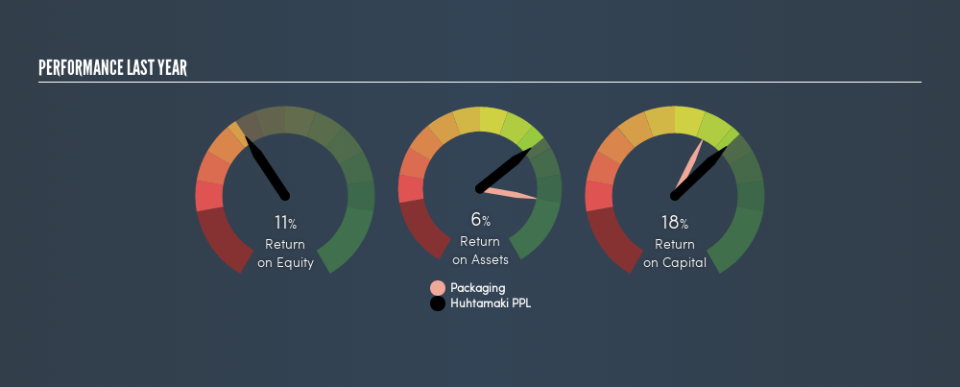Has Huhtamaki PPL Limited (NSE:PAPERPROD) Been Employing Capital Shrewdly?

Today we are going to look at Huhtamaki PPL Limited (NSE:PAPERPROD) to see whether it might be an attractive investment prospect. In particular, we'll consider its Return On Capital Employed (ROCE), as that can give us insight into how profitably the company is able to employ capital in its business.
First of all, we'll work out how to calculate ROCE. Next, we'll compare it to others in its industry. Last but not least, we'll look at what impact its current liabilities have on its ROCE.
What is Return On Capital Employed (ROCE)?
ROCE is a metric for evaluating how much pre-tax income (in percentage terms) a company earns on the capital invested in its business. All else being equal, a better business will have a higher ROCE. In brief, it is a useful tool, but it is not without drawbacks. Renowned investment researcher Michael Mauboussin has suggested that a high ROCE can indicate that 'one dollar invested in the company generates value of more than one dollar'.
How Do You Calculate Return On Capital Employed?
The formula for calculating the return on capital employed is:
Return on Capital Employed = Earnings Before Interest and Tax (EBIT) ÷ (Total Assets - Current Liabilities)
Or for Huhtamaki PPL:
0.18 = ₹1.7b ÷ (₹15b - ₹4.9b) (Based on the trailing twelve months to March 2019.)
So, Huhtamaki PPL has an ROCE of 18%.
Want to participate in a short research study? Help shape the future of investing tools and you could win a $250 gift card!
Check out our latest analysis for Huhtamaki PPL
Is Huhtamaki PPL's ROCE Good?
When making comparisons between similar businesses, investors may find ROCE useful. It appears that Huhtamaki PPL's ROCE is fairly close to the Packaging industry average of 16%. Independently of how Huhtamaki PPL compares to its industry, its ROCE in absolute terms appears decent, and the company may be worthy of closer investigation.
Remember that this metric is backwards looking - it shows what has happened in the past, and does not accurately predict the future. Companies in cyclical industries can be difficult to understand using ROCE, as returns typically look high during boom times, and low during busts. ROCE is, after all, simply a snap shot of a single year. Future performance is what matters, and you can see analyst predictions in our free report on analyst forecasts for the company.
Do Huhtamaki PPL's Current Liabilities Skew Its ROCE?
Current liabilities are short term bills and invoices that need to be paid in 12 months or less. Due to the way the ROCE equation works, having large bills due in the near term can make it look as though a company has less capital employed, and thus a higher ROCE than usual. To counter this, investors can check if a company has high current liabilities relative to total assets.
Huhtamaki PPL has total assets of ₹15b and current liabilities of ₹4.9b. Therefore its current liabilities are equivalent to approximately 34% of its total assets. Huhtamaki PPL has a medium level of current liabilities, which would boost the ROCE.
Our Take On Huhtamaki PPL's ROCE
Huhtamaki PPL's ROCE does look good, but the level of current liabilities also contribute to that. Huhtamaki PPL looks strong on this analysis, but there are plenty of other companies that could be a good opportunity . Here is a free list of companies growing earnings rapidly.
For those who like to find winning investments this free list of growing companies with recent insider purchasing, could be just the ticket.
We aim to bring you long-term focused research analysis driven by fundamental data. Note that our analysis may not factor in the latest price-sensitive company announcements or qualitative material.
If you spot an error that warrants correction, please contact the editor at editorial-team@simplywallst.com. This article by Simply Wall St is general in nature. It does not constitute a recommendation to buy or sell any stock, and does not take account of your objectives, or your financial situation. Simply Wall St has no position in the stocks mentioned. Thank you for reading.

